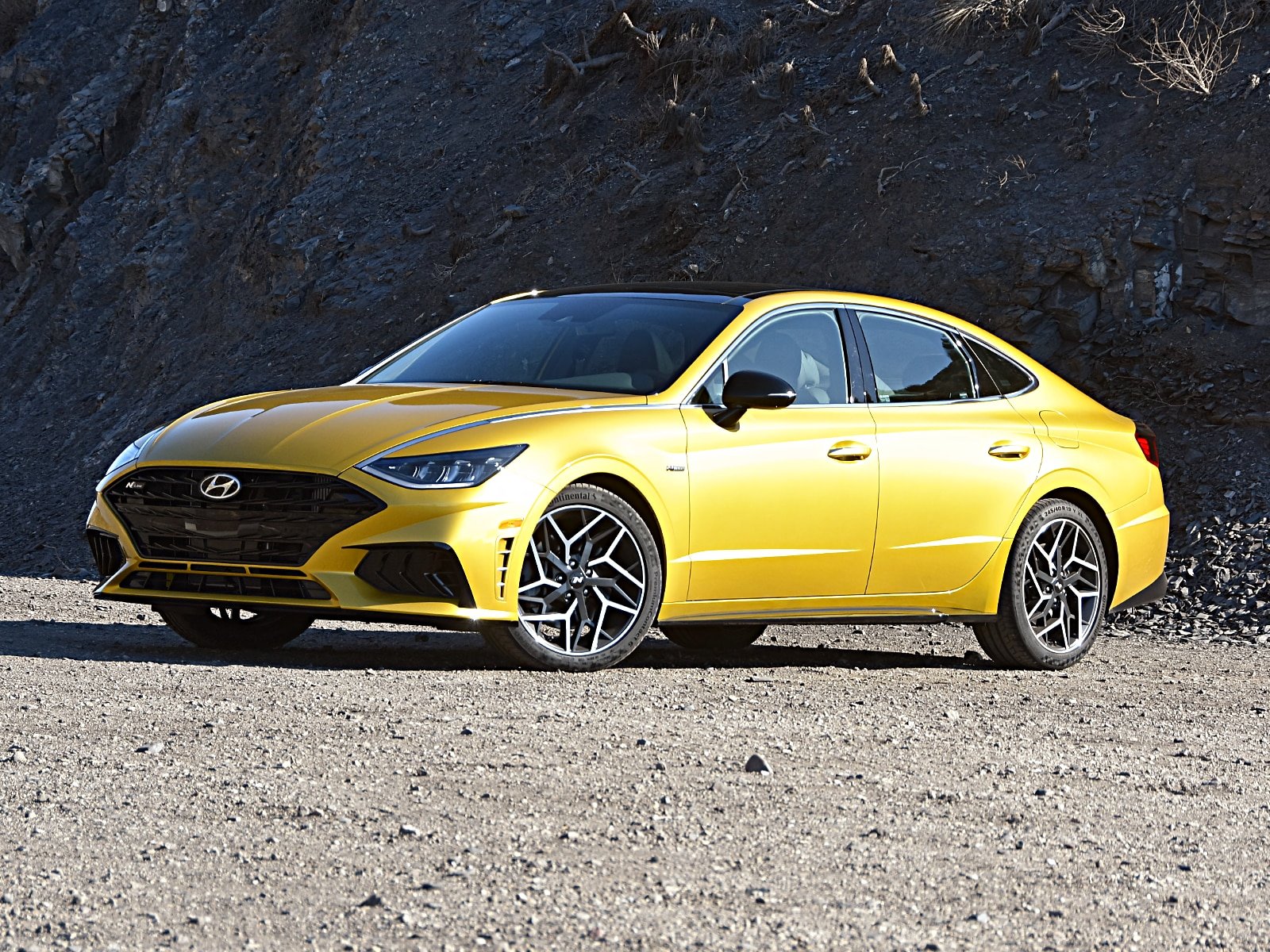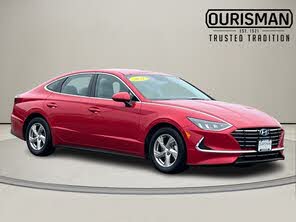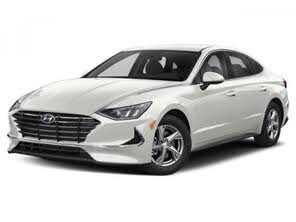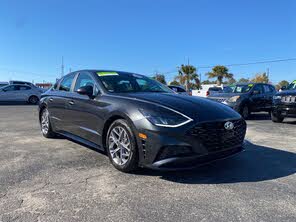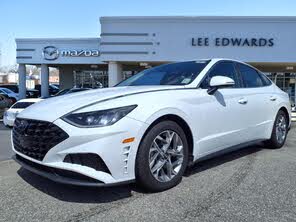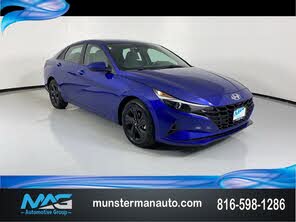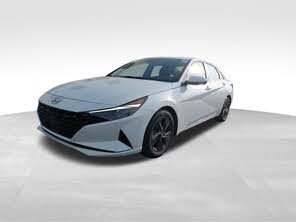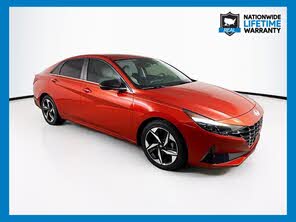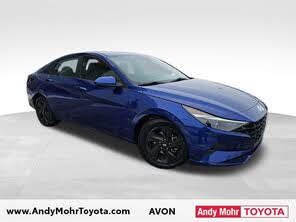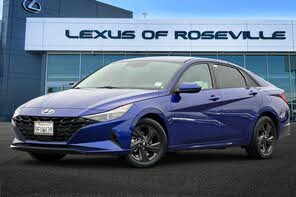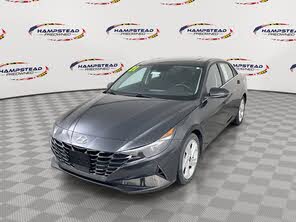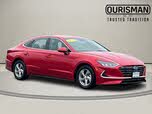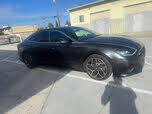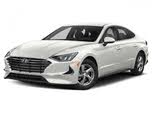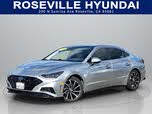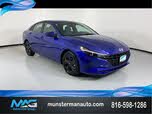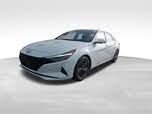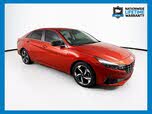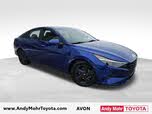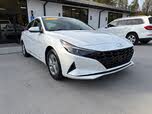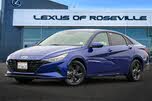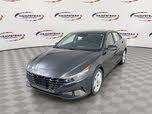2021 Hyundai Sonata vs 2021 Hyundai Elantra
Overview | |
MSRP$19,650 | MSRP$23,950 |
Listings694 | Listings764 |
Ratings & Reviews | |
User Reviews | User Reviews |
Expert reviews8.8 out of 10 | Expert reviews8.5 out of 10 |
Pros
Cons
| Pros
Cons
|
2021 Hyundai Elantra Reviews SummaryCompact cars are no longer compact. Cheap cars are no longer cheap. And it is no longer necessary to buy a luxury vehicle for performance, technology, and sophistication. The redesigned 2021 Hyundai Elantra proves it. | |
2021 Hyundai Sonata Reviews SummaryIn a shrinking car market, the traditional sport sedan is increasingly rare. Designed and developed for people who prefer on-pavement performance but need passenger and cargo practicality, only a handful of dedicated non-premium sport sedans still exist, and most of those barely qualify for membership in the club. Enter the new 2021 Hyundai Sonata N Line, which addresses both performance and practicality in a compelling midsize package and at a bargain price. | |
Popular Features & Specs | |
Engine2.0L 147 hp I4 | Engine2.5L 191 hp I4 |
Drive TrainFWD | Drive TrainFWD |
Seating Capacity5 | Seating Capacity5 |
Horsepower147 hp @ 6200 rpm | Horsepower191 hp @ 6100 rpm |
MPG City31 | MPG City27 |
MPG Highway41 | MPG Highway37 |
Engine | |
Engine Name2.0L 147 hp I4 | Engine Name2.5L 191 hp I4 |
Torque132 lb-ft @ 4500 rpm | Torque181 lb-ft @ 4000 rpm |
Horsepower147 hp @ 6200 rpm | Horsepower191 hp @ 6100 rpm |
DrivetrainFWD | DrivetrainFWD |
Fuel Economy | |
MPG City31 | MPG City27 |
MPG Highway41 | MPG Highway37 |
Interior | |
Seating Capacity5 | Seating Capacity5 |
Safety | |
Front Crash Overall | Front Crash Overall4 |
Side Crash Overall | Side Crash Overall5 |
Dimensions & Capacity | |
Cargo Space14.2 cu ft | Cargo Space16.3 cu ft |
Curb Weight2725 lbs | Curb Weight3120 lbs |
Height55.7 in | Height56.9 in |
Length184.1 in | Length192.9 in |
Width71.9 in | Width73.2 in |
Wheelbase107.1 in | Wheelbase111.8 in |
Maximum Payload1133 lbs | Maximum Payload1234 lbs |
Number of doors4 | Number of doors4 |
Overview | ||
MSRP | $19,650 | $23,950 |
Listings | ||
Ratings & Reviews | ||
User reviews | ||
Expert reviews | 8.8 out of 10Read full review | 8.5 out of 10Read full review |
Pros & cons | Pros
Cons
| Pros
Cons
|
Summary | Compact cars are no longer compact. Cheap cars are no longer cheap. And it is no longer necessary to buy a luxury vehicle for performance, technology, and sophistication. The redesigned 2021 Hyundai Elantra proves it. | In a shrinking car market, the traditional sport sedan is increasingly rare. Designed and developed for people who prefer on-pavement performance but need passenger and cargo practicality, only a handful of dedicated non-premium sport sedans still exist, and most of those barely qualify for membership in the club. Enter the new 2021 Hyundai Sonata N Line, which addresses both performance and practicality in a compelling midsize package and at a bargain price. |
Video | ||
Popular Features & Specs | ||
Engine | 2.0L 147 hp I4 | 2.5L 191 hp I4 |
Drive Train | FWD | FWD |
Seating Capacity | 5 | 5 |
Horsepower | 147 hp @ 6200 rpm | 191 hp @ 6100 rpm |
MPG City | 31 | 27 |
MPG Highway | 41 | 37 |
Engine | ||
Engine Name | 2.0L 147 hp I4 | 2.5L 191 hp I4 |
Torque | 132 lb-ft @ 4500 rpm | 181 lb-ft @ 4000 rpm |
Horsepower | 147 hp @ 6200 rpm | 191 hp @ 6100 rpm |
Drivetrain | FWD | FWD |
Fuel Economy | ||
MPG City | 31 | 27 |
MPG Highway | 41 | 37 |
Interior | ||
Seating Capacity | 5 | 5 |
Safety | ||
Front Crash Overall | 4 | |
Side Crash Overall | 5 | |
Dimensions & Capacity | ||
Cargo Space | 14.2 cu ft | 16.3 cu ft |
Curb Weight | 2725 lbs | 3120 lbs |
Height | 55.7 in | 56.9 in |
Length | 184.1 in | 192.9 in |
Width | 71.9 in | 73.2 in |
Wheelbase | 107.1 in | 111.8 in |
Maximum Payload | 1133 lbs | 1234 lbs |
Number of doors | 4 | 4 |
The 2021 Hyundai Elantra was a standout in the compact sedan category, thanks to Hyundai’s Sensuous Sportiness design language and Parametric surfacing. Its sharp creases and dramatic angles gave it a distinctive and appealing look. The Z-shaped dent in the car’s doors, a controversial design cue, was intended to help the Elantra stand out and break conventional automotive design rules. This bold styling worked to the Elantra’s benefit, making it a unique choice in its segment.
Inside, the Elantra featured a driver-focused dashboard and center console, with higher trim levels offering a more upscale and high-tech cabin. The Limited or Hybrid Limited trims in Gray were particularly impressive, with light gray seats and trim providing a modern and upscale look. However, the SEL with the Premium Package had a drabber black interior with less appealing glossy black plastic.
The 2021 Hyundai Sonata, redesigned for the 2020 model year, was a love-it-or-hate-it proposition with its daringly distinctive design. The N Line treatment amplified the Sonata’s appeal with functional and stylistic changes, such as larger air intakes, gloss black side mirrors, and bold 19-inch aluminum alloy wheels. The rear featured a subtle gloss black lip spoiler and a reworked bumper with a lower diffuser panel flanked by a four-outlet exhaust system, giving the Sonata a stealthy performance look.
Inside, the Sonata N Line featured sport front seats with premium Nappa leather bolsters and Dinamica suede inserts, red stitching, aluminum pedal covers, and dark chrome accents. A standard panoramic sunroof added to the car’s roominess and two-tone appearance. The interior was both sporty and comfortable, making it a pleasant place to be whether driving for fun or simply commuting.

















The 2021 Hyundai Elantra offered a range of powertrain options, each with its own driving characteristics. The standard 2.0-liter 4-cylinder engine produced 147 horsepower and 132 pound-feet of torque, paired with a CVT. This setup provided adequate power for urban driving but felt underwhelming on the highway. The Elantra Hybrid, with a 1.6-liter Atkinson-cycle engine and electric motor, delivered 139 horsepower and better fuel efficiency, though it fell short of EPA estimates in mountainous driving conditions.
The Elantra N Line, with a turbocharged 1.6-liter engine producing 201 horsepower and 195 pound-feet of torque, offered a more engaging driving experience. It featured a sport-tuned suspension, quicker steering, and larger brakes, making it fun to drive on winding roads. The high-performance Elantra N, with a turbocharged 2.0-liter engine generating 276 horsepower and 289 pound-feet of torque, was the most thrilling of the lineup, offering a dynamic and refined driving experience.
The 2021 Hyundai Sonata N Line was powered by a turbocharged 2.5-liter four-cylinder engine, producing 290 horsepower and 311 pound-feet of torque. Paired with an eight-speed wet DCT, the Sonata N Line offered impressive acceleration and a satisfying engine note. The car featured Normal, Sport, Sport+, and Custom driving modes, allowing drivers to tailor the driving experience to their preferences. The sport-tuned suspension, larger brakes, and 19-inch wheels with performance tires contributed to the Sonata N Line’s agile handling and composed ride.
In real-world driving, the Sonata N Line proved to be a treat, with its added stiffness, responsive steering, and firm underpinnings. The car felt glued to the ground on winding roads, while the suspension effectively managed body roll and excess motion. Despite its sporty nature, the Sonata N Line remained comfortable and quiet on highways and in city driving, making it a versatile choice for various driving conditions.
The 2021 Hyundai Elantra, classified as a midsize car by the EPA, offered a spacious and comfortable interior. The driver’s seat was height-adjustable, and the tilt/telescopic steering wheel made it easy to find a comfortable driving position. Heated front seats were standard, with the Limited Hybrid adding ventilated front cushions. However, the lack of a height-adjustable front passenger seat and the use of hard plastic for the upper door panels were notable drawbacks.
Rear-seat legroom in the Elantra was impressive, nearly matching that of the larger Sonata. However, the backrest shape and angle left something to be desired in terms of upper back support. The Elantra also lacked rear air conditioning vents and USB charging ports. Storage space was practical, with a 14.2-cubic-foot trunk and a 60/40-split folding rear seat for added utility.
The 2021 Hyundai Sonata N Line featured heated front sport seats with Dinamica suede inserts for added comfort and lateral support. The front passenger seat was height-adjustable, making the Sonata N Line more accommodating for both front-seat occupants. Rear-seat passengers enjoyed air conditioning vents and a USB port, though the hard plastic front seatback panels could be uncomfortable for taller passengers.
Interior storage in the Sonata N Line was generous, with a practical center console design. The trunk offered 16 cubic feet of space, and the 60/40-split folding rear seat expanded utility when needed. The Sonata N Line also included Hyundai’s Smart Trunk hands-free release feature, which automatically opened the trunk when standing near the back of the car for three seconds.
The 2021 Hyundai Elantra came with a range of technology features, depending on the trim level. The SE, SEL, and N Line trims had traditional instrumentation with an 8-inch touchscreen infotainment system, offering wireless Apple CarPlay and Android Auto. The SEL and N Line also included satellite radio and Blue Link connected services, with the N Line adding wireless smartphone charging.
The Limited trim featured a 10.25-inch touchscreen infotainment system paired with a 10.25-inch digital instrumentation screen, both housed under a single piece of glass. This setup included navigation, a dynamic natural voice recognition system, and a Sounds of Nature function. However, wireless smartphone integration was lost with the larger screen, though full-screen or split-screen Apple CarPlay and Android Auto were available. A new Bose premium sound system and Hyundai Digital Key were also available.
The 2021 Hyundai Sonata N Line was equipped with a 12.3-inch digital instrumentation panel and a 10.25-inch touchscreen infotainment system. Standard features included navigation, wireless smartphone charging, a Bose premium sound system, HD Radio, SiriusXM satellite radio, Apple CarPlay, Android Auto, and a three-year subscription to Blue Link connected services. However, the lack of a tuning knob and the placement of the volume control knob could be frustrating.
The Sonata N Line’s infotainment system also offered Sounds of Nature, providing ambient noise tracks to reduce stress. Hyundai Digital Key was standard, allowing Android smartphone users to unlock the doors and start the engine. Unfortunately, this feature was not available for iPhone users.
The 2021 Hyundai Elantra was built on a new platform with multiple structural collision energy pathways to absorb and disperse collision energy. Every Elantra came with Hyundai’s SmartSense suite of advanced driving assistance systems (ADAS), including forward collision warning, automatic emergency braking, lane-departure warning, lane-keeping assistance, lane-centering assistance, automatic high-beam headlights, and a driver attention warning system. Additional safety features included blind-spot warning, rear cross-traffic warning, Rear Occupant Alert, and Safe Exit Warning. Higher trims offered cyclist detection, junction turning assistance, adaptive cruise control, rear automatic braking, and Highway Drive Assist.
The 2021 Hyundai Sonata N Line also came with a comprehensive version of Hyundai’s SmartSense ADAS. This included adaptive cruise control, forward-collision warning, automatic emergency braking, lane-departure warning, lane-keeping assistance, lane-centering assistance, blind-spot warning, rear cross-traffic warning, driver-attention warning, and automatic high-beam headlights. Additional features included Rear Occupant Alert, Safe Exit Warning, and Highway Drive Assist. The Sonata N Line’s ADAS performed smoothly and accurately, reducing driver stress and enhancing safety.
CarGurus highlights

According to CarGurus experts, the overall rating for the 2021 Hyundai Elantra is 8.8 out of 10, while the 2021 Hyundai Sonata scores 8.5 out of 10. Based on these ratings, the 2021 Hyundai Elantra is the recommended choice, offering a better overall package with its distinctive design, spacious interior, and range of powertrain options.
Choose the 2021 Hyundai Sonata if:
- You seek a midsize sedan with a sporty and stealthy appearance.
- You desire a powerful turbocharged engine with engaging driving dynamics.
- You appreciate advanced technology and a comprehensive suite of safety features.
Choose the 2021 Hyundai Elantra if:
- You prefer a compact sedan with a distinctive and bold design.
- You value a spacious interior with impressive rear-seat legroom.
- You want a range of powertrain options, including a high-performance variant.
CarGurus highlights

According to CarGurus experts, the overall rating for the 2021 Hyundai Elantra is 8.8 out of 10, while the 2021 Hyundai Sonata scores 8.5 out of 10. Based on these ratings, the 2021 Hyundai Elantra is the recommended choice, offering a better overall package with its distinctive design, spacious interior, and range of powertrain options.
Choose the 2021 Hyundai Sonata if:
Shop Now- You seek a midsize sedan with a sporty and stealthy appearance.
- You desire a powerful turbocharged engine with engaging driving dynamics.
- You appreciate advanced technology and a comprehensive suite of safety features.
Choose the 2021 Hyundai Elantra if:
Shop Now- You prefer a compact sedan with a distinctive and bold design.
- You value a spacious interior with impressive rear-seat legroom.
- You want a range of powertrain options, including a high-performance variant.

By: CarGurus + AI
At CarGurus, our team of experienced automotive writers remain at the heart of our content operation, conducting hands-on car tests and writing insightful guides that are backed by years of industry experience. To complement this, we are harnessing AI to make our content offering more diverse and more helpful to shoppers than ever. To achieve this, our AI systems are based exclusively on CarGurus content, ratings and data, so that what we produce is both unique to CarGurus, and uniquely helpful to car shoppers.
